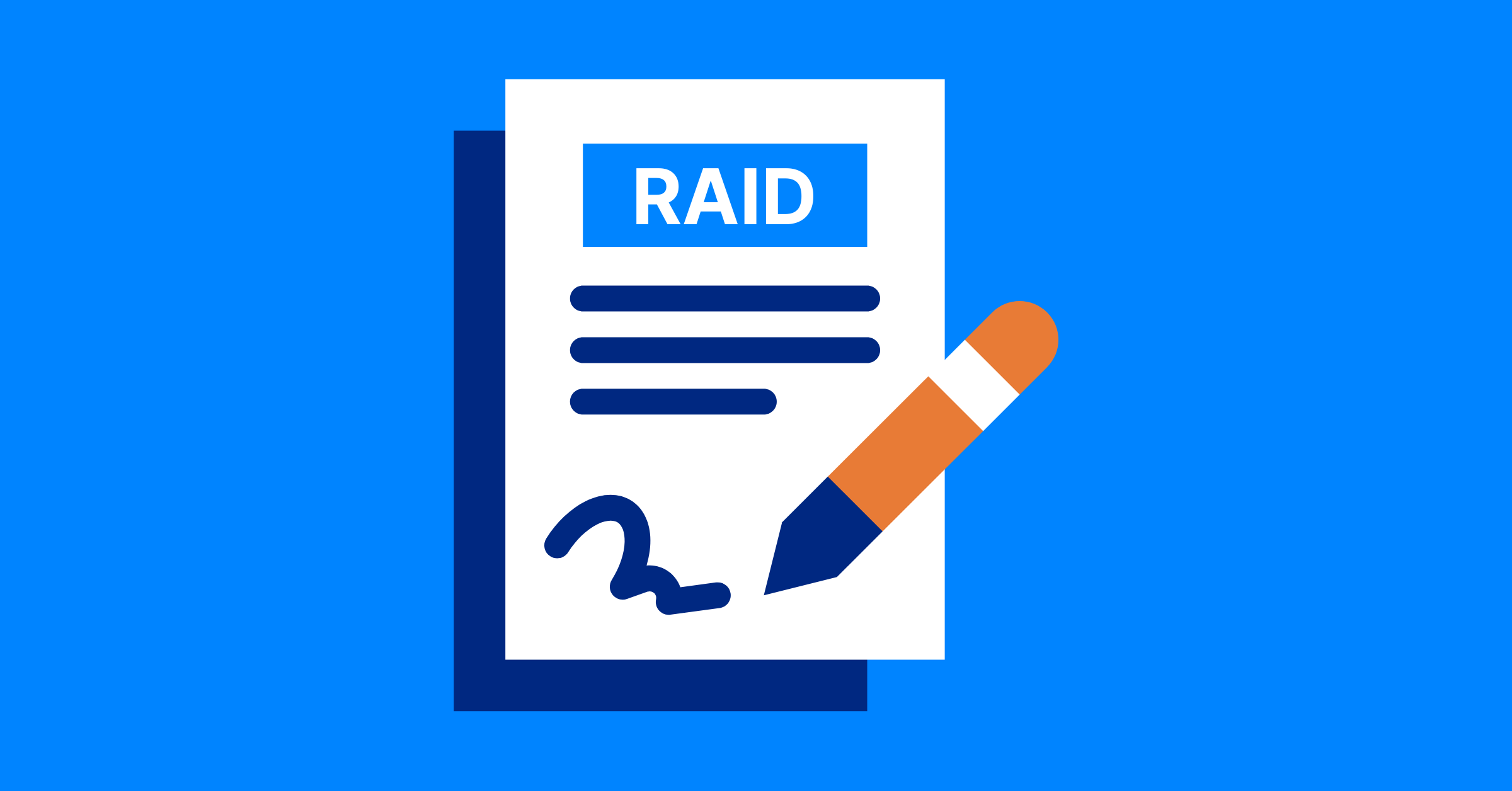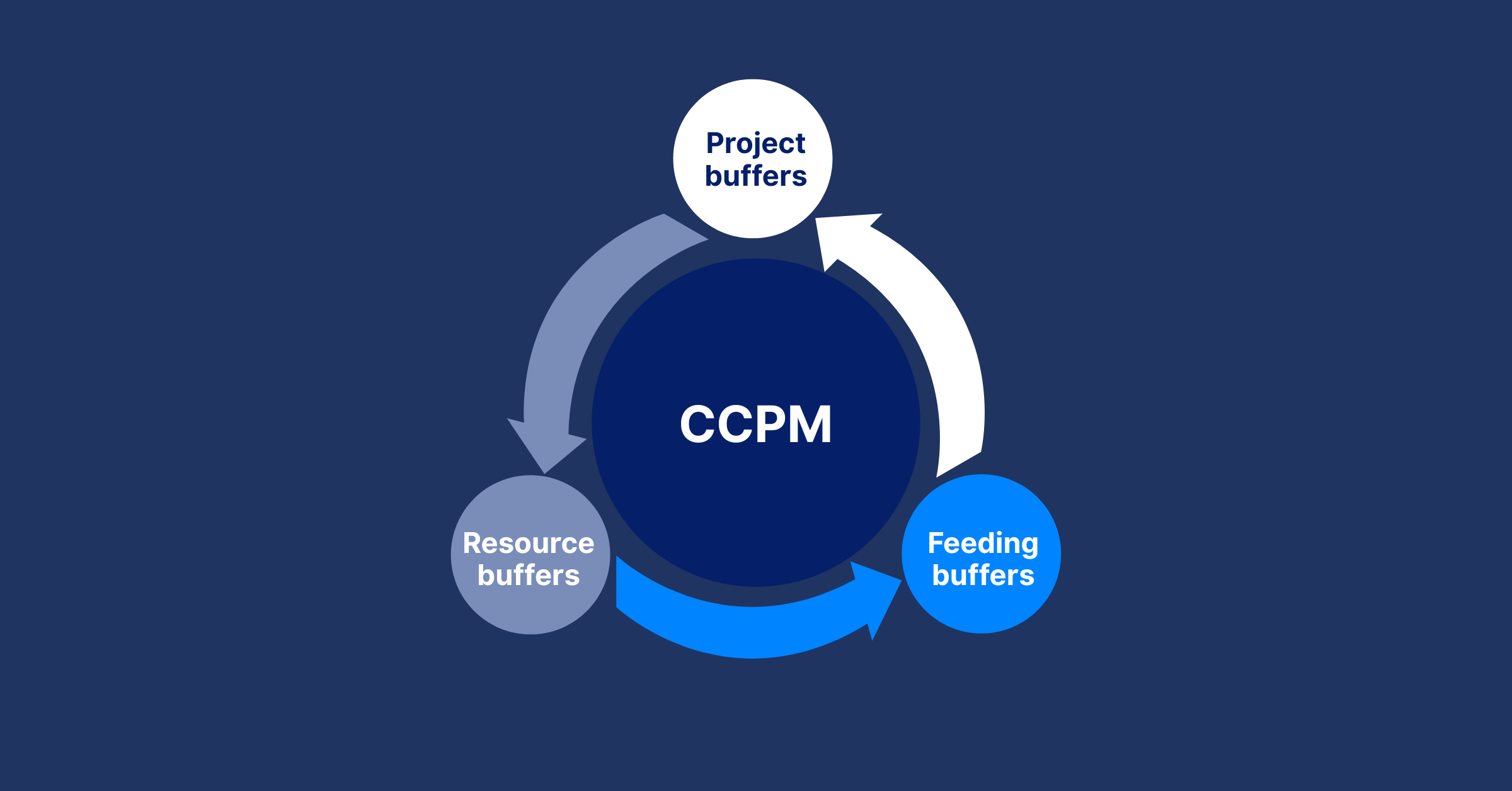Organize Technical Communication for Clear IT Project Delivery
Organize technical communication for clear IT project delivery using spatial, chronological, prioritization, comparative, and problem–solution methods.
Technical communication bridges the gap between technology and understanding. In IT project management, it transforms complex technical details into clear, actionable information. When documentation lacks structure or consistency, even the most well-planned projects can stumble. Misunderstandings multiply, timelines slip, and accountability fades.
Effective technical communication brings order to that chaos. It connects design decisions, implementation steps, and business objectives into one coherent narrative. By presenting the right information in the right format, it ensures that every stakeholder, from engineers to clients, can find what they need and act on it confidently. This article explores how strong technical communication enhances clarity, efficiency, and collaboration in IT project management.
Why Technical Communication Defines Clear IT Project Delivery
Technical communication plays a central role in IT project delivery because it keeps people, processes, and technology aligned. Every update, report, and document contributes to how a team executes a project.
When communication is organized, teams gain three major benefits:
- Clarity: Everyone understands their roles, objectives, and timelines.
- Consistency: Information is formatted and stored in predictable ways, reducing errors.
- Efficiency: Team members spend less time interpreting and more time executing.
Inconsistent communication, on the other hand, leads to rework and delays. A software developer might misread specifications, or a project sponsor might misinterpret a progress report. These small misunderstandings can multiply quickly.
Following the Project Management Institute (PMI) framework, structured communication is part of sound project governance. A well-designed project communication plan defines what information will be shared, who will receive it, and how often. This creates accountability and ensures that information flows smoothly from initiation to closure.
The Role of Structure in Effective Technical Communication
Structure is what turns raw data into knowledge. It helps organize information logically so that readers can easily follow complex ideas.
In IT project management, a structured approach to technical communication offers:
- Traceability: Each document links clearly to business requirements and project goals.
- Accountability: Teams know which deliverables depend on which tasks.
- Scalability: As projects grow, structured communication keeps information manageable.
When communication lacks structure, project teams waste time asking for clarification. A structured message, however, lets them act immediately. Whether you are writing a design document or reporting an incident, structure provides predictability that makes complex information easier to absorb.
Organizational Frameworks to Strengthen Technical Communication
Different types of projects and audiences require different communication frameworks. Choosing the right structure helps readers process information without confusion. Below are five proven patterns that help make IT documentation clear, consistent, and purposeful.
1. Spatial Structure in Technical Communication – Mapping System Architecture
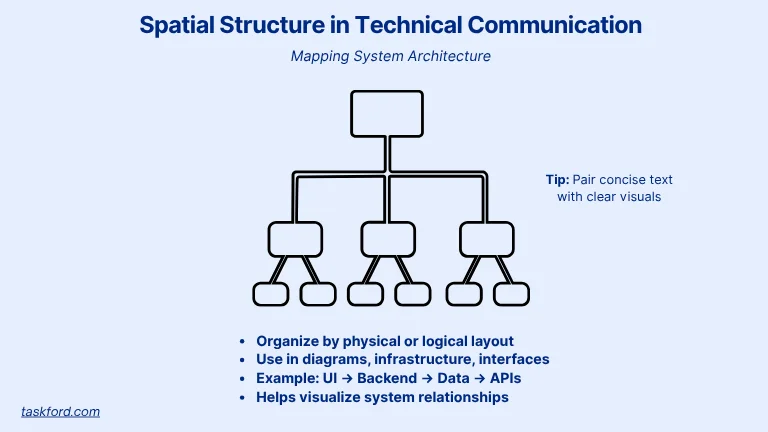
Spatial organization arranges content according to physical or logical layout. It is commonly used in architecture diagrams, infrastructure designs, and interface documentation.
When describing a cloud-based system, for example, spatial organization might begin with the top layer (user interface), then move downward through backend services, data storage, and APIs. This order mirrors how systems are built and helps readers visualize relationships among components.
This structure is also useful in describing security layers, network zones, or data flow paths. When paired with visuals such as diagrams and tables, spatial communication makes it easier for engineers and managers to see how different parts connect.
Best Practice: Combine concise technical explanations with visuals. Readers should be able to trace how one layer supports another without jumping between unrelated sections.
2. Chronological Structure in Technical Communication – Sequencing Project Timelines
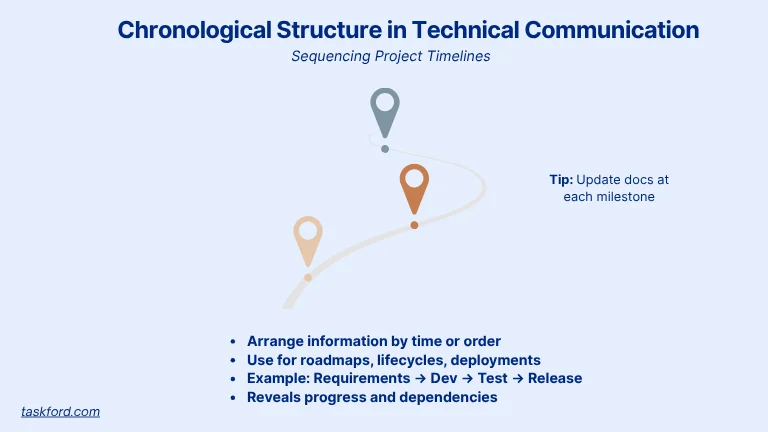
Chronological organization presents information in the order events occur. It suits any content that describes processes, progress, or time-based dependencies.
This pattern works well for:
- Implementation roadmaps
- Development lifecycles
- Testing or deployment sequences
For instance, a rollout plan could describe the sequence from requirements gathering, through development, testing, user acceptance, and final release. Each phase includes specific deliverables and decision checkpoints.
Chronological organization also helps during post-project reviews. By documenting what happened first and what followed, teams can trace cause-and-effect relationships and identify lessons learned.
Best Practice: Align your documentation updates with project milestones. This reinforces consistency between your written communication and actual progress.
3. Prioritization Structure in Technical Communication – Order of Importance
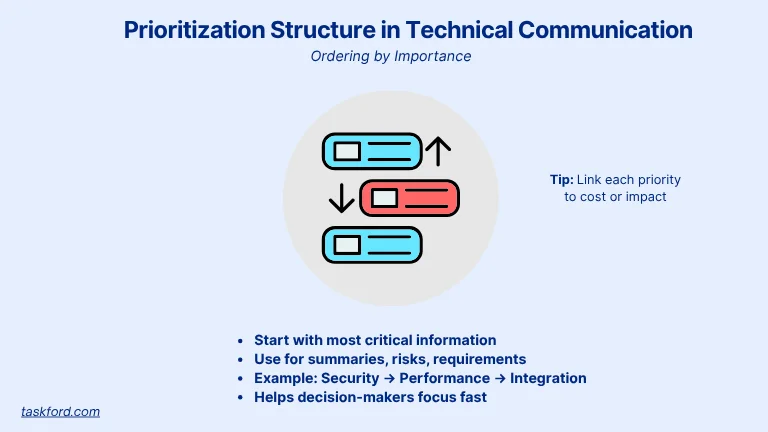
In IT project management, decision-makers often need information ranked by relevance. Prioritization structure organizes content from most to least critical.
This format works best in:
- Executive summaries
- Risk assessments
- System requirement outlines
Start with the most impactful items. For example, list top project risks first, such as data security vulnerabilities, performance issues, or integration delays. Once the key items are explained, add supporting information and lower-priority details.
By front-loading the most essential content, readers grasp the main message immediately, even if they do not read the entire document. This is especially useful for time-constrained stakeholders who rely on quick summaries for decision-making.
Best Practice: Use short, focused paragraphs to explain each priority item. Add brief context on how each one affects cost, schedule, or performance.
4. Comparative Structure in Technical Communication – Evaluating Technology Options
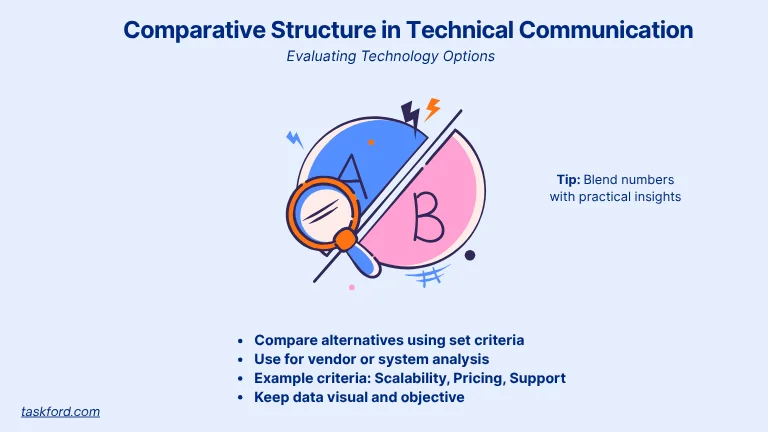
Comparative structure is used when analyzing two or more alternatives. IT project managers often use it in feasibility studies or vendor evaluations.
When writing a comparison, identify the criteria first, such as scalability, pricing model, technical support, and integration capabilities. Then compare each option side by side using a table or matrix.
Example:
| Criteria | AWS | Azure |
|---|---|---|
| Scalability | Excellent | Excellent |
| Pricing Flexibility | Pay-as-you-go | Pay-as-you-go with reservations |
| Ecosystem Support | Strong community | Strong enterprise backing |
By aligning the same criteria across options, the comparison stays objective and readable. Avoid overwhelming readers with data dumps. Instead, focus on which factors matter most to the project’s success.
Best Practice: Combine quantitative metrics with qualitative insights. For example, include both performance benchmarks and ease of configuration to give a balanced evaluation.
5. Problem–Solution Structure in Technical Communication – Documenting Challenges and Fixes
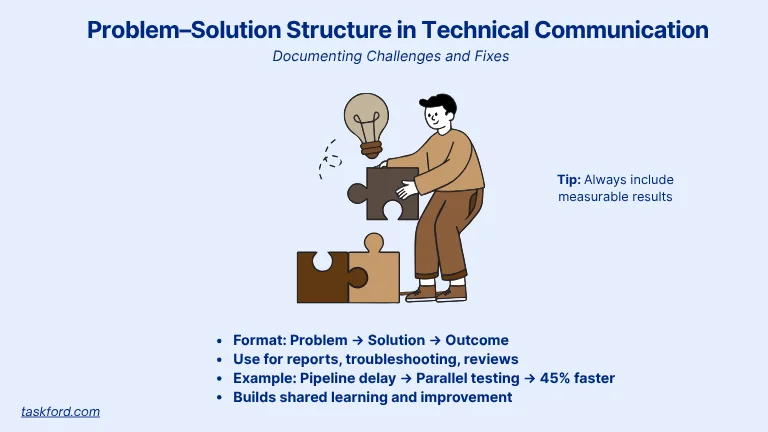
The problem–solution format is direct and highly practical. It presents a challenge, the steps taken to resolve it, and the measurable outcome. This approach fits incident reports, troubleshooting guides, or retrospectives.
Example:
- Problem: The automated testing pipeline increased deployment times.
- Solution: Introduced parallel testing and caching mechanisms.
- Outcome: Reduced build time by 45 percent.
This pattern is especially valuable for knowledge transfer. Future teams can revisit these documents to avoid repeating past mistakes.
Best Practice: Always include metrics showing improvement. Quantified results give credibility and demonstrate measurable progress.
Integrating Multiple Structures in Advanced Technical Communication
Many IT documents benefit from combining several organizational structures. A single project report might include chronological order for describing the rollout process, spatial structure for system design diagrams, and problem–solution format for summarizing technical issues.
When blending structures:
- Use clear subheadings to signal transitions.
- Provide brief summaries after each major section.
- Use consistent formatting across different structural patterns.
For example, a migration report could begin with a problem–solution overview of the legacy system’s challenges, move into chronological steps describing migration phases, and end with a spatial diagram of the new architecture.
Integrating structures makes communication adaptable and complete. Each section reinforces the others, creating a unified narrative that speaks to both technical and non-technical audiences.
Tailoring Technical Communication to Different Audiences
Effective technical communication depends on understanding who the message is for. The same information can be presented differently depending on the audience.
Executives and sponsors:
- Prefer prioritization structures.
- Expect concise overviews, risk summaries, and business impact statements.
Developers and engineers:
- Prefer chronological and spatial structures.
- Need detailed steps, diagrams, and configuration data.
Clients or end-users:
- Respond best to problem–solution formats.
- Want clear explanations of how issues are resolved and what benefits result.
When creating a project communication plan, always identify your primary readers. Tailoring structure and tone improves engagement and prevents confusion across roles.
Tools and Techniques for Organizing Technical Communication
Modern IT teams rely on digital tools to manage and distribute project information. Structured communication becomes easier when supported by a consistent documentation environment.
Recommended tools:
- Confluence: For collaborative documentation and structured templates.
- Google Docs: For flexible content sharing and version control.
- Markdown editors: For technical documentation that developers can easily update.
- TaskFord: For teams that need a comprehensive project management and resource planning platform that provides file sharing and commenting functions for smooth collaboration.
Techniques for structure:
- Use numbered sections for clarity.
- Apply consistent headers and bullet points.
- Add tables or visual elements for data-heavy content.
- Review and update documentation at every project phase.
When tools and structure align, communication remains organized even as projects scale.
Pitfalls That Undermine Technical Communication Clarity
Even experienced teams can make mistakes that weaken communication. Common pitfalls include:
- Switching between structures without transitions. Readers lose context and coherence.
- Using too much jargon. Technical depth should not come at the cost of readability.
- Neglecting document updates. Outdated content damages trust and accuracy.
- Ignoring audience needs. Information that is too detailed or too vague wastes time.
To avoid these issues, build communication reviews into your IT project management process. Periodic audits ensure that all materials remain accurate, consistent, and accessible.
Building a Sustainable Project Communication Plan
A strong communication plan turns structure into a repeatable process. It defines how information is created, maintained, and distributed throughout the IT project life cycle.
To make it sustainable:
- Assign ownership for each document type.
- Set update schedules tied to project milestones.
- Maintain templates for reports and deliverables.
- Establish approval steps to maintain quality.
A project communication plan should evolve with the project. As priorities shift, so should message timing, frequency, and format. The more consistent this process becomes, the more predictable and reliable your technical communication will be.
Conclusion: Mastering Technical Communication for Project Success
Organized technical communication turns complex projects into coordinated efforts. It improves clarity, enhances accountability, and strengthens decision-making at every level. Each communication structure has a unique role. Together, they create a toolkit that adapts to different audiences and purposes.
Technical communication is not just about writing. It is about managing knowledge in a way that supports collaboration and precision. When structured well, it becomes the foundation of every successful IT project delivery. Review one of your recent project reports. Identify which structure dominates and how it could be improved. A small adjustment in structure may be all that stands between confusion and clarity.
Learn more
- Mapping Technical Requirements in Complex IT Projects
- Real-World Agile Project Management with Scrum - Lessons from the TaskFord Team
- What Is Project Management: A Beginner’s Comprehensive Guide 2025
Making work simpler,
smarter, and more connected
Join our waitlist and be notified first.

Related Blog
Subscribe for Expert Tips
Unlock expert insights and stay ahead with TaskFord. Sign up now to receive valuable tips, strategies, and updates directly in your inbox.


